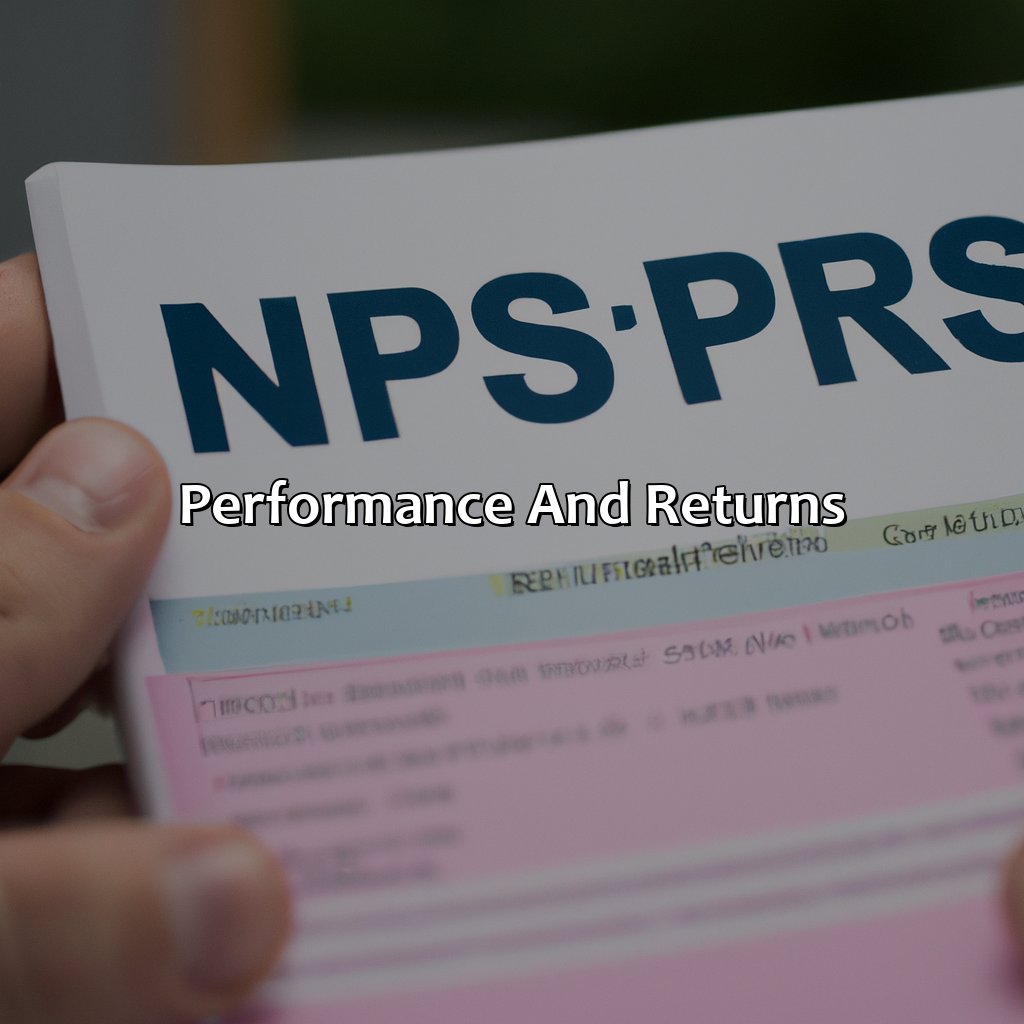What Is New Pension Scheme Nps?
Key Takeaway:
- The New Pension Scheme (NPS) is a voluntary, defined contribution retirement savings scheme that aims to provide retirement income for Indian citizens. It is regulated by the Pension Fund Regulatory and Development Authority (PFRDA).
- Key features of NPS include investment options, tax benefits, flexibility, and portability. NPS offers various investment options such as equities, corporate bonds, and government securities. It also provides tax benefits to subscribers and allows for flexibility in contributions and withdrawals.
- To be eligible for NPS, any Indian citizen between the ages of 18 and 65 can apply. The enrollment process is simple and can be done online or through an authorized representative.
- NPS has investment limits and withdrawal rules that are regulated by the PFRDA. Subscribers can choose from various annuity options upon retirement that provide a fixed income stream.
- NPS has historically delivered better returns than traditional retirement savings options like EPF and PPF. The management of funds is done by professional fund managers appointed by the PFRDA.
- When compared with other pension plans, NPS has unique features and benefits that make it a favorable option for retirement savings.
- In conclusion, NPS offers a flexible and tax-efficient retirement savings option that can help individuals secure their financial future.
Are you confused about the New Pension Scheme (NPS)? Worry not, here you’ll get to understand the working of NPS and the various benefits it offers to help you plan your retirement. You can make more informed decisions and plan for your future.
Overview of New Pension Scheme (NPS)
New Pension Scheme (NPS) is a government-regulated pension scheme available to all Indian citizens between the ages of 18 and 65. Its objective is to provide stable and sustainable income in the twilight years. Participants can opt for different investment options that range from low to high risk, giving more control over their retirement savings. The National Pension System Trust manages the funds, and the scheme is open both to employees in the organised sector and to the self-employed.
Participants are categorised based on their risk appetite, with three levels – conservative, moderate, and aggressive, each with an assigned asset allocation portfolio. The return generated by the scheme depends on the performance of the market, with many experts suggesting that NPS investments are a lucrative option for a balanced retirement portfolio.
NPS was introduced in January 2004 for government employees and later expanded to the private sector in May 2009. It’s part of the government’s initiative to ensure financial security and encourage savings in the country. Since its inception, the scheme has evolved to become more customer-friendly, with options for partial withdrawals and a lump sum payment of up to 60% of the corpus on retirement.

Image credits: retiregenz.com by David Duncun
Features of NPS
Gain insights on what to expect from NPS with its options, tax benefits, flexibility, and portability. Get a detailed breakdown of sub-sections to understand the key features of this pension scheme. Learn how these features help build a stable financial future.

Image credits: retiregenz.com by David Woodhock
Investment options
For those seeking investment options under NPS, there are several choices available. Let’s explore these options.
- Equity – Invest in diversified equity funds for growth potential over the long term.
- Corporate Debt – Invest in high-rated corporate bonds for a steady income stream.
- Government Securities – Invest in sovereign securities for capital protection and minimal risk.
- Alternative Assets – Invest in infrastructure trusts, real estate investment trusts (REITs) or other such assets for further diversification of portfolio.
- AUTO Investment – Opting for this option allows the allocation of funds across asset classes based on your age bracket. It ensures that your investments remain optimally balanced throughout your life cycle.
- Limited Investment Choice – For those who wish to take a more conservative approach with a predefined mix of equities and fixed incomes may opt into this category.
It’s noteworthy that individuals can choose their preferred allocation percentage between the different asset classes and change it up twice every financial year. Investors must keep in mind that withdrawal is allowed post-retirement, only when attaining the age of 60 years. In case of premature withdrawals, investors must follow specific rules prescribed by the NPS regulations.
To optimize investments under the NPS scheme, it is advisable to weigh the pros and cons of each option carefully before making an informed decision. It’s also wise to seek advice from professional financial advisors who have expertise regarding the nuances associated with building an appropriate financial plan with NPS investment options.
Getting tax benefits with NPS is like getting a free handkerchief with a coffin – it’s not much, but it’s better than nothing.
Tax benefits
The NPS comes with several attractive tax benefits for investors. Contributions made towards NPS by individuals and their employers are eligible for tax deductions under Section 80C of the Income Tax Act. Additionally, there is an additional deduction available for investment made in NPS up to a maximum of Rs. 50,000 under section 80CCD(1B).
On maturity, the entire corpus received by an investor is exempt from tax up to 40% of the amount withdrawn at the time of retirement, and remaining balance needs to be invested in annuity plans. To know more about pension funds in South Africa, visit our website.
One unique feature of the NPS is that it allows investors to switch between different fund managers as per their preferences. This flexibility enables them to shift their investments between Equity (E), Corporate Bonds (C), and Government Securities (G) funds based on market conditions without any penalty charges.
Pro Tip: It is recommended to plan your investments in such a way that you can maximize your tax benefits while also minimizing your risks. Consult with a financial advisor or read more on the official NSDL website to get a better understanding of how to manage your NPS investments effectively. Flexibility is key, unless you’re a pension plan, then it’s just a painful stretch.
Flexibility
The NPS is highly flexible, allowing individuals to customize their investment strategy and choose their preferred fund manager. Investors can select from various asset classes like equities, corporate bonds, and government securities based on their risk tolerance and investment objectives. Additionally, subscribers can alter the asset allocation ratio every year to suit their changing needs. This ensures that the scheme stays relevant to the unique requirements of each investor.
Furthermore, NPS subscribers also have complete control over the timing and amount of contributions made towards their retirement savings. Individuals can make ad-hoc contributions in addition to regular payments and withdraw funds as required. This feature enables individuals to maximize their returns by investing more when they have surplus funds and withdrawing the money only when necessary.
Interestingly, a study conducted by CRISIL found that the equity portion of NPS has consistently outperformed other government-backed schemes over a five-year period.
Switching jobs has never been so easy, thanks to NPS – it’s like having a travel-sized pension plan!
Portability
Being mobile and adaptable is a key concept in the New Pension Scheme (NPS). The system’s Portability feature allows subscribers to transfer their accumulated benefits from one sector to another without requiring the intervention of their employers. This feature ensures that the employee’s retirement savings earn interest regardless of where they work.
This feature is particularly beneficial for employees who switch jobs frequently, as well as those in the unorganized sector who are not eligible for traditional pension plans. Portable accounts can be transferred electronically with minimum paperwork, significantly reducing service processing time.
Furthermore, portability also guarantees minimal government interference and complete autonomy over contributions, investment choices and withdrawals.
It is reported that NPS Portability came into existence following prolonged efforts by pensioners’ rights groups and socially-conscious individuals. In acknowledgment of their demands, the Indian Government introduced this feature in 2010 as part of a widespread reform to enhance social security for all its citizens.
Enrolling in NPS is easier than getting out of a conversation with an overly enthusiastic acquaintance.
Eligibility and Enrollment
Are you eligible for NPS solution? To figure it out, you have to meet some criteria. We’ll give you an overview of these requirements and explain how to enroll in the scheme. Look at the ‘Who can apply for NPS’ and ‘Enrollment process’ sub-sections to find out more!

Image credits: retiregenz.com by David Arnold
Who can apply for NPS
Potential applicants for NPS can include any Indian citizen aged between 18-65 years. Additionally, non-resident Indians with Indian citizenship are eligible to apply. Corporate entities and groups can also apply for the scheme for the purpose of providing it to their employees. However, it is worth noting that only Tier-I account holders can avail of government securities and equity market investments.
Furthermore, self-employed individuals such as lawyers, doctors, architects and other professionals can also enroll under NPS. Pension Fund Regulatory and Development Authority (PFRDA) provides a flexible system in which NRIs residing in 42 countries may also participate in the scheme.
Additionally, NPS offers two types of accounts Tier I and Tier II accounts. The former is mandatory for all government employees; however, the latter is an optional investment account.
It is worth noting that since April 1st, 2020 central government employees will have the option to select one out of four pension fund managers namely HDFC Pension Management Company Limited (HDFC), ICICI Prudential Life Insurance Co Ltd (ICICI), Kotak Mahindra Pension Fund Limited (Kotak), and Reliance Pension Fund (R-PF).
According to Business Today India’s report, NPS assets surged by over Rs.90 crore in January 2021, with new enrolments rising by 4.5% YoY at approximately 563 thousand subscribers.
Enrolling in the new pension scheme is like signing up for a gym membership, except your future retirement is the muscle you’re trying to flex.
Enrollment process
To participate in NPS, an individual must go through the registration process. Here’s a guide to the ‘Membership Registration Process’ for NPS:
- Fill out the application form available on the CRA’s website or any POPSP.
- Submit KYC details along with the application form to your chosen POPSP.
- Collect Permanent Retirement Account Number (PRAN) from your chosen POPSP after verification of documents.
- Activate your PRAN by logging into your account on the CRA’s website using I-PIN and submitting other necessary details.
- Choose a pension fund manager as per your investment choice.
- Start contributing towards NPS through various channels like auto-debit, payroll deductions, etc.
It is important to note that opening an NPS account is voluntary and can be done by any Indian citizen aged between 18-60 years.
NPS offers multiple Tier options, each having distinct features in terms of flexibility, investment choices and withdrawal criteria.
A friend of mine who worked in the private sector enrolled in NPS last year at age 45. He opted for a conservative approach in his investment choice and plans to use the accumulated corpus towards his post-retirement expenses.
Because who needs money for retirement when you can just live on the edge and hope for a miracle? Welcome to the Contribution and Withdrawal section of the new pension scheme NPS!
Contribution and Withdrawal
This part of the article focuses on NPS. It provides solutions about investment limits, withdrawal rules and annuity options. It helps you understand the basics of NPS. So, you can make wise decisions when contributing or withdrawing from your NPS account. Keep informed about the contribution and withdrawal process of NPS!

Image credits: retiregenz.com by Yuval Duncun
Investment limits
For those curious about the limits on investing in the new pension scheme, NPS, here is a breakdown of the investment limits. The contribution amount is determined by various factors such as age and income. The minimum annual contribution required for Tier-I and Tier-II accounts is Rs. 1,000 per annum and Rs. 250 per annum respectively. The investment limit for Tier-I account stands at Rs. 2 lakh while there are no upper limits for Tier-II account. Below is a table showcasing the details of the investment limits of NPS.
| Account Type | Minimum Contribution | Maximum Contribution |
|---|---|---|
| Tier-I | Rs. 1,000 | Rs. 2 lakh |
| Tier-II | Rs. 250 | No Limits |
It’s worth noting that unlike other pension schemes, NPS allows partial withdrawals under certain circumstances while keeping in mind the safety nets to avoid draining off everything at once. Are you still unsure about contributing to NPS? Don’t let FOMO get you! Start planning your retirement today with NPS to safeguard your future finances with this lucrative savings scheme! Ready to withdraw from your NPS? Just remember, you can’t have your cake and eat it too…unless your cake is retiring comfortably.
Withdrawal rules
When Can One Withdraw Funds From The New Pension Scheme (NPS)?
The New Pension Scheme or NPS has a defined set of rules when it comes to withdrawing funds. Here’s what you need to keep in mind:
- Partial withdrawals are allowed after a minimum of three years from the account opening.
- You can withdraw up to 25% of your contribution as long as you submit proof that the funds will be used for specific purposes such as education, marriage, or medical treatment.
- You can make one more partial withdrawal after five years but only if the previous withdrawal had proof of specific use. If not, you’ll have to wait another five years until the next withdrawal.
- If you retire or reach the age of 60, you can withdraw up to 60% of accumulated wealth immediately. The remaining amount will be used for purchasing an annuity plan.
- In case of death before reaching the age of 60, beneficiaries can withdraw up to 100% of accumulated wealth along with accrued interest or purchase an annuity plan.
It’s important to note that there is no option for complete withdrawal until retirement or reaching 60 years of age.
While most people are aware that partial withdrawals are allowed after three years, few know about the five-year gap between subsequent withdrawals without sufficient proof.
A relative once had to wait ten extra years for another partial withdrawal because a previous withdrawal didn’t meet specific-use criteria. The delay impacted their plans significantly and is something others should be mindful of while planning their investments.
Remembering these rules and planning accordingly can help ensure that you’re making the most out of your NPS investment and avoiding any unnecessary delays.
Choosing an annuity option is like picking a flavor at an ice cream shop, except you’ll be stuck with it for the rest of your life.
Annuity options
For those opting for the retirement plan under the NPS, they have an array of options to choose from regarding their annuity.
There are mainly two types of annuities available –
- Immediate annuity: In this option, once the investor retires, they can start taking their pension immediately.
- Deferred annuity: Under this option, the investor can defer their pension starting date. The longer the delay in starting to receive a pension, the higher will be the returns.
Other than these options, there are also several variations available that can provide different benefits based on individual requirements and preferences. Here is a breakdown of some popular options:
| Annuity Option | Features |
| Life-long Annuity with Return of Corpus: | Pension payment for life with purchase price returned to nominee after death |
| Life-long Annuity with Annuity Certain: | Pension payment for life; guaranteed payouts for 5/10/15 years even if investor dies before that period. |
| NPS Joint Life annuity: | Pension paid jointly (50% pension to each) to investors and their spouse until both pass away. |
It is worth noting that choosing an annuity option depends on your investment portfolio, expected returns from investments made in NPS along with personal needs and preferences. It is advisable to seek professional financial advice before making any decision.
Pro tip: Keep in mind that changing or modifying the chosen pension plan or switching between various available options might not always be allowed. Make sure to check restrictions before you start investing.
Prepare to be pleasantly surprised by the performance and returns of NPS, because retirement should be a time of rest and relaxation, not financial stress.
Performance and Returns
To know how your investment’s doing and to decide what to do with New Pension Scheme (NPS), analyze Performance & Returns of NPS. Look at two key things: historical returns & fund management.

Image credits: retiregenz.com by Joel Woodhock
Historical returns
Looking back: Examining the Historical Returns of New Pension Scheme NPS
| Year | Equity | Corporate Bonds | Government Bonds |
| 2015-16 | 7.49% | 8.52% | 9.27% |
| 2016-17 | 18.87% | 12.96% | 9.13% |
| 2017-18 | 12.79% | 6.67% | 2.07% |
Grasping an in-depth understanding of this subject, we can gauge that historical returns provide a clear insight into how the New Pension System fared throughout different periods. It is essential to know that, during these periods, equity was never negative, and the government bonds’ fluctuations were minimal.
A real-life example that stands out was when a friend invested in NPS’s corporate bond option and earned 10% from it while another friend made only around two percent less from government bonds invested via bank FDs, emphasizing the importance of NPS options to maximize one’s returns.
Managing funds is like juggling flaming knives, but with the NPS, at least you have a safety net.
Management of funds
The allocation and management of funds in the New Pension Scheme (NPS) is critical in determining returns for investors. With varying risk profiles, the scheme offers two investment options: Active Choice and Auto Choice. Active Choice allows investors to determine the composition of their portfolio while Auto Choice invests based on the investor’s age and risk profile. The Pension Fund Managers (PFMs) are responsible for investing the funds as per the guidelines set by NPS Trust. They focus on diversification to manage risk, selecting stocks and bonds with long-term growth potential.
Moreover, NPS provides both Tier I and Tier II accounts for different investment horizons. While Tier I account mandates an initial minimum contribution to enjoy tax benefits, Tier II offers unlimited withdrawals but without any tax benefits. To provide flexibility to investors, NPS also allows portability between PFMs.
To maximize returns, investors should periodically review their portfolio’s performance and shift funds across asset classes where needed. Additionally, it is essential to start investing early to benefit from compounding interest, which is a significant contributor to long-term wealth creation.
Other pension plans might have their perks, but when it comes to performance and returns, the NPS is a real retirement MVP.
Comparison with other Pension Plans
Got to know the contrast between NPS and other pension plans? Compare it with EPF, PPF and the rest. Check out these subsections for a clear comprehension of NPS pros and cons compared to different pension plans.

Image credits: retiregenz.com by David Washington
Comparison with EPF
EPF Scheme versus NPS- A Comparative Analysis
EPF and NPS are two of the most popular pension plans available in India. Below is a table illustrating the key differences between these two schemes.
| Parameters | EPF | NPS |
| Tax Benefit on Investment | Exempted in Employee Contribution; Employer’s Contribution upto 12% is deducted from CTC before tax calculation. | Tax benefit up to INR 2 Lakhs in a financial year under Section 80C. |
| Withdrawal Rules | The employee can withdraw after retirement or resignation after two months of unemployment but taxed accordingly. The employee can partially withdraw for specific reasons like education, marriage, or medical expenses, amongst others. | An individual can withdraw the money from NPS only upon reaching the age of retirement or upon one’s death. In case of partial withdrawals allowed with limited conditions. |
| Investment Options | The investments made by EPFO are invested in Government Securities, Debt Instruments, Equities & Mutual Funds. The option to choose investment preferences are not given to subscribers and investment decisions depend on EPFO management’s decisions. | NPS allows asset allocation variety with three categories as equity funds, corporate debt funds and government security funds along with an option of auto-investment choice for subscribers. |
The following benefits of NPS include portability, choice of the investment option and funds, transparent transactions and overall flexibility. Moreover, subscribers have exclusive access to update or switch fund managers, change asset allocation preferences etc.
To highlight one unique advantage of NPS is that it is portable. One can transfer their account from one location to another without much hassle.
A recent article talks about Ajay, a 45-year-old man who realized late in life that he needed to plan his retirement better. Switching careers was likely going to happen again for him and having options with portability mattered greatly.”
If the PPF were a person, they’d be that friend who always has a jar of coins for emergencies, while the NPS is the friend who’s already planning their retirement vacation to Bali.
Comparison with PPF
The comparison of the New Pension Scheme (NPS) with Public Provident Fund (PPF) can help investors make an informed choice.
| New Pension Scheme(NPS) | Public Provident Fund(PPF) | |
|---|---|---|
| Returns | Market-linked, average returns up to 10% | Fixed, average returns up to 7.1% |
| Fund Management | NPS Trust manages funds; multiple PFM options available | Managed by the government |
| Tax benefits | Investments up to Rs.2 lakhs are tax-deductible under Section 80C and additional deductions up to Rs.50,000 under Section 80CCD. However, withdrawals at retirement are taxable. | Investments up to Rs.1.5 lakhs are tax-deductible under Section 80C. Interest earned is tax-free, but maturity amount is taxable. |
| Liquidity | Premature withdrawal allowed at a certain cost with partial withdrawal facility twice till retirement age | Premature withdrawal available after the end of the sixth financial year at a specific cost |
| Income replacement value | The NPS is designed to provide a regular income during old age and hence serves as a replacement for pension benefits that others are provided with by their employers or the government. | It may not serve as an alternative retirement plan or income replacement solution due to limited investment flexibility in terms of equity allocation and tenure restrictions. |
NPS offers higher returns and management options, while PPF provides a fixed rate of return with government management. However, NPS contributions are taxable at withdrawal and PPF is exempt from income tax. The NPS serves as a pension replacement offering regular income to provide retired individuals financial independence. Meanwhile, the lack of equitable allocation can limit PPF’s ability to serve as an alternative retirement plan. Investors must choose between PPF or NPS based on their investment objectives, long-term planning needs, and risk appetite. For example, younger investors who want equity exposure in their portfolios may prefer NPS to complement other investments. On the other hand, investors looking for stable returns and lower speculation can opt for PPF instead. Ultimately, one should consult with their financial advisor before making a decision based on their individual circumstances. Who needs a crystal ball when you have the new pension scheme? It’s a guaranteed future of retirement fun!
Comparison with other pension plans
The new pension scheme NPS could be compared to other existing pension plans in the market. The following table showcases a brief comparison of NPS with some popular pension schemes.
| Pension Scheme | Type | Returns | Taxation |
|---|---|---|---|
| NPS | Defined Contribution Pension Scheme | Market-linked returns, average 9-12% p.a. over 10 years | Partial Withdrawals are tax-free, lump sum withdrawal is taxed at maturity as per applicable tax slab |
| EPS | Defined Benefit Pension Scheme (for employees) | Fixed returns based on salary and years of service. Average return is 8.5% p.a. | Partial withdrawals are not allowed until a certain age, annuity payments are taxable |
| PPF | Fixed Deposit Scheme for Retirement Savings | Fixed returns between 7-8% p.a. | EEE benefits – contributions, interest and maturity amount all tax-free |
Unique features of NPS include portability across jobs and flexibility in contribution amounts. It offers a wider array of investment options than its counterparts and has no cap on voluntary contributions.
The National Pension System was first introduced in the year 2004 as an alternative to traditional pension schemes. Initially available for government employees only, it was later made open to all Indian citizens in 2009, except those from the armed forces.
Five Facts About New Pension Scheme (NPS):
- ✅ New Pension Scheme (NPS) is a voluntary retirement savings account scheme. (Source: Times of India)
- ✅ NPS offers two types of accounts to subscribers – Tier I and Tier II. (Source: PFRDA)
- ✅ Tier I account is mandatory for all government employees joining after 1 January 2004. (Source: Economic Times)
- ✅ NPS offers various investment options for subscribers, including equity, government securities, and corporate bonds. (Source: NPS Trust)
- ✅ NPS provides tax benefits to subscribers under Section 80CCD of the Income Tax Act. (Source: BankBazaar)
FAQs about What Is New Pension Scheme Nps?
What is new pension scheme NPS?
New Pension Scheme (NPS) is a government-sponsored pension scheme, launched by the Pension Fund Regulatory and Development Authority (PFRDA) which provides a defined contribution pension plan.
Who is eligible for NPS?
All Indian citizens are eligible to join NPS, including employees from the public, private and unorganized sectors. NRIs can also invest in NPS, but they can only do so through their NRE/NRO accounts.
How does NPS work?
NPS works on the defined contribution basis, wherein the subscriber contributes regularly towards their pension account during their working life. Upon retiring, the subscriber can withdraw a portion of the corpus as a lump sum and use the remaining to purchase an annuity for a regular pension income.
What are the tax benefits of investing in NPS?
Investment in NPS offers tax benefits under Section 80CCD(1) of the Income Tax Act, 1961. In addition, an additional tax deduction of Rs 50,000 is allowed for investment in NPS under Section 80CCD(1B) of the Income Tax Act.
How to open an NPS account?
An individual who wishes to open an NPS account must submit their KYC documents, fill in a registration form, and pay the initial contribution amount. One can open an NPS account through a Point of Presence (POP) or online through the NPS website.
Can I change my investment preference under NPS over time?
Yes, an NPS subscriber can change their investment preference over time by opting for different fund managers, asset allocation ratios, and investment schemes. Subscribers can switch their investment options twice a year at no extra cost.
